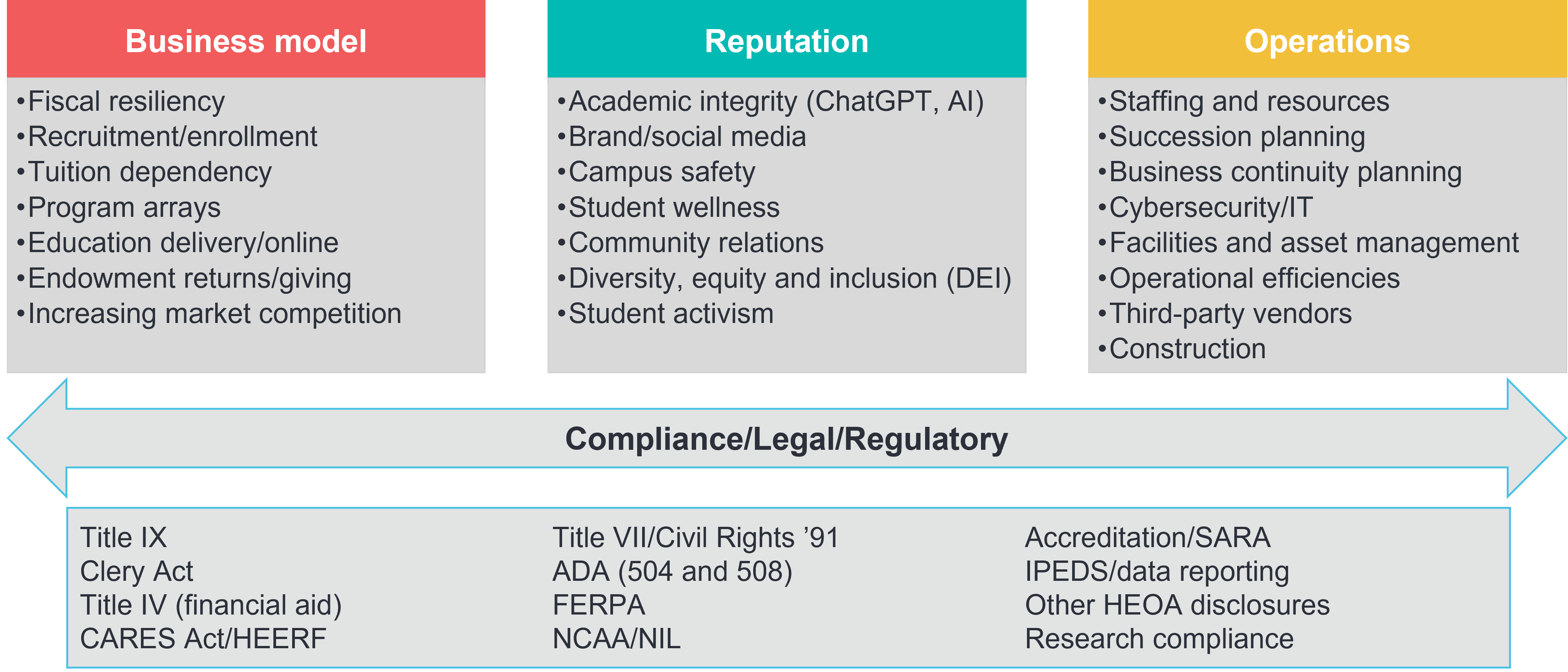
Board diligence for top strategic risks
Key takeaways from 2023’s Association of Governing Boards of Universities and Colleges (AGB) National Conference on Trusteeship
During this year’s AGB conferences, Baker Tilly Higher Education Practice Leader Dave Capitano and Managing Director Christine Smith facilitated an interactive panel with board leaders and professionals about strategic risks across the higher education enterprise. The discussion served to equip board members with insights that are critical to navigate risks and focus diligence for student and institutional success.
This session explored how boards can successfully anticipate strategic risks that could bump their institutions off course. The panel addressed board frameworks, methods of operating and nuanced ways of board management that can keep institutions on track in the face of evolving context and conditions – defined as strategic risk categories.
Trending risks in higher education
The discussion commenced with a reflection on top risks facing most colleges and universities:

The panelists agreed that college and university boards are challenged to understand and address risks across myriad institutional areas as identified below.

Today’s higher education environment may be more complex than ever before due to the rippling student and economic impacts the pandemic has had across the industry.
Strategic risks – a deeper dive
Although much has evolved across the higher education ecosystem, what has not changed is that a board governs the institution. An institution’s board must proactively anticipate strategic risks and understand how to stay on course relative to institutional objectives despite challenges that could take the college or university off track. Within the context of this discussion, strategic risks are defined as, “opportunities and threats to achieving the institution’s goals and intended outcomes.” And, each and every board decision can impact the achievement of these objectives.
The panel raised the following questions and offered insight to help board members diligently assess strategic risks:
- What is the appropriate board role in managing strategic risks?
- What are some pitfalls boards encounter that prevent them from managing strategic risks?
- What is key to boards that excel at driving the right communication and actions?
- How can the board position itself to provide the appropriate level of diligence related to these strategic risks?
- When things get off course, what can the board do to get back on track?
In the AGB session, panelists and attendees explored potential steps to address the following strategic risks with a focus on student success and fiscal resiliency/affordability:
Strategic risks

- Align degree programs with market demand
- Boost online learning and community college transfers
- Expand workforce credentials
- Advance working adults’ careers by upskilling or reskilling
- Provide holistic student advising
- Understand it’s a process
- Gather and analyze data
- Identify problems and priorities
- Build partnerships
- Strategically stabilize finances
- Consider freezing student costs
Regardless of the risk, a critical conversation point was the perspective of evolving the understanding and discussion of a strategic risk over time – especially when considering how to ensure president and board alignment.
Keys to improved board oversight
Achieving college and university board member alignment requires intentional and carefully orchestrated board discussion. Consider the following tips for improving board oversight for strategic risks.
Position the board to proactively address strategic risks. Key activities include:
- Center and align priorities around institutional and student success. Then, let form follow
- Have a strong, transparent working relationship between the board chair and institutional leader (e.g., president, chancellor)
- In the cycle of learn/engage/react, spend enough time in the “messy middle” of engage
- Commit to continuous back-and-forth engagement with institutional stakeholders and campus constituents
- Collaborate on decision-making through effective communication protocols, conversation arcs, data analytics and backwards planning
- Avert analysis paralysis. Consider, “can we move forward with 80% comfort?”
Avoid common board pitfalls. Roadblocks to managing strategic risks include:
- An inability to accept the institution’s financial realities – 75% of presidents nationwide indicated their institution’s financial health was improving. Not everyone agrees; push the courageous conversation
- Unawareness of data in key trends (e.g., enrollment, expenses, spending, endowment, etc.) – practice rigor in data-sharing, analysis and discussion
- Lack of governance infrastructure and approaches to stay engaged – plan carefully overtime
- Not front-loading expectations and being timely with communication – slowly evolve toward decisions
- Poor alignment with the “business” of higher education – what is your institution’s specific mission? Assess your position relative to public good and market competitiveness
Summary
It is essential for boards to consistently recognize and evaluate the institution’s performance relative to its mission, strategic priorities and student success metrics. This must continuously cascade into all board activities (i.e., board education, alignment of plenary and committee structure and agendas, calls to action/approval, etc.). Timely engagement and communications are critical to ensuring a strong and healthy relationship between the board chair and leadership.
Remember that things do not always go as planned. Thus, expect to proactively collaborate as mid-course corrections or urgent actions are required. It is okay to challenge the status quo and get comfortable with being uncomfortable in this highly dynamic landscape.
Are you ready to design an effective road map to help your institution’s board address strategic risks? Contact our higher education specialists now, for tomorrow.
